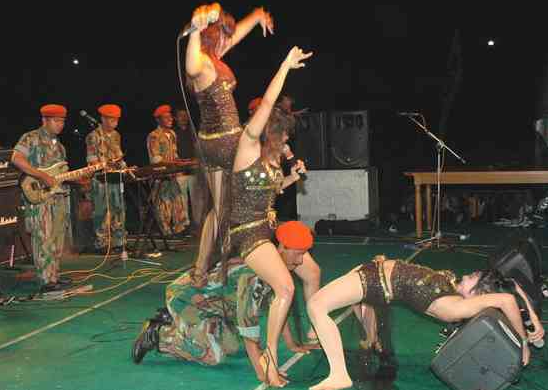TEN TANG MUSIK DANGDUT DI INDONESIA
The mention of "dangdut" is a sound game onomatope of tabla (drum called dangdut in the world of course) Indian music. Putu Wijaya was originally called the issue of Tempo magazine May 27, 1972 that the song Doll from India is a mixture of Malay songs, the rhythm of the desert, and "ding-dang-dut" India.Sebutan is then condensed into a "dangdut" only, and by the magazine used to refer to the form of Malay songs that are affected by the song of India.From music to Malay Dangdut
Contemporary dangdut has been different from its roots, Malay music, though people can still feel his touch.
Malay Orchestra (commonly abbreviated as OM, which is still frequently used term for a group of dangdut music) the original use of musical instruments like acoustic guitar, accordion, tambourine, harp, and flute, even a gong. In the 1950s and 1960s, many developing-orchestra in Jakarta Malay orchestra that plays songs from the Deli Malay Sumatra (around Medan). At this time the experiment began to enter the entry of Indian elements in the Malay music. The development of world cinema at that time and anti-Western politics of President Sukarno becomes fertilizer for these groups. From this period can be noted names such as P. Ramlee (of Malaya), Said Effendi (with the song Seroja), Indoku (the style of the stage like a dancer of India, the creator of the Dolls from India), Husein Bawafie (one of the songwriters Lamentations Stepchildren), Munif Bahaswan (creator Expense Asmara), and M. Mashabi (creator of the film score "Lamentations Stepchildren" is very popular in the 1970's).
Or tabla drum, one of the major musical instrument dangdut.
This period of musical styles continues to survive through the 1970s, although at that time also been major changes in the Malay music scene that was driven by Sonnet Group leader Rhoma Irama. Some names from the 1970s can be called is Mansyur S., Ida Laila, A. Rafiq, and Muchsin Alatas. Malay popular music can be seen from the release of several albums by the group of Malay pop music pop Koes Plus in its heyday.
Modern dangdut, which developed in the early 1970s in line with Indonesia's political culture that is friendly to the West, include musical instruments such as the Western modern electric guitar, electric organ, percussion, trumpet, saxophone, oboe, and others to increase the variation creativity as a musician and land-musicians. Mandolin also entered as an important element. The influence of rock (especially the guitar) is very thick felt on dangdut music. The 1970s were the scene of 'battle' for dangdut music and rock music in the music market seize Indonesia, to have held concerts 'duel' between Sonnet Group and God Bless. Practically from the time of this Malay music has changed, including the pattern of musical business.
In the latter half of the 1970s also developed variations of "dangdut humor" that was driven by the Arc of Light petromaks OM (PSP). This orchestra, which departs from the style of music melayu deli, helping dangdut dissemination among students. This subgenre forwarded, for example, by OM Introduction Drinking Poison (PMR) and, in the early 2000s, the Hope Nation Youth Orchestra (PHB).
Published July 2nd, 2011
Tags: music, dangdut, indonesia



good post
ReplyDeleteVia Vallen Gumantunge Roso mp3
Via Vallen Setia (Jikustik Cover) Mp3
Stafaband
Tambanglagu - Download Lagu Mp3 Terbaru
vialagu
relagu
Download Musik
relagu - download mp3
Post a Comment